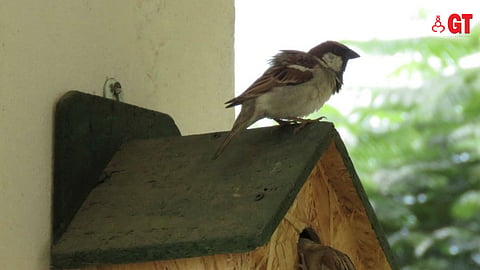

Have you in the last few days, months or years, taken a moment of your time to look around? You might notice that the once commonly-found house sparrow is difficult to spot or is becoming increasingly rare.
These birds, which were found in abundance around houses or having sand baths in the garden, are gradually disappearing, and moving towards villages.
Talking about sparrows, on World Sparrow Day, Mohammed Dilawar, president of Nature Forever Society, explained to Gomantak Times Digital that these birds are always found wherever there are humans.
“The sparrows have evolved around humans and you can find them in the hottest places like Delhi, to a coastal place like Goa and also the coldest places like Jammu and Kashmir,” Dilawar said.
The sparrows have evolved around humans and you can find them in the hottest places like Delhi, to a coastal place like Goa and also the coldest places like Jammu and Kashmir
Mohammed Dilawar, President of Nature Forever Society
MOVED TO THE VILLAGES
Sparrows have a strong affinity for human settlements, which makes them exceptionally loyal companions. Being avid grain eaters, they used to indulge in rice husks discarded by women during the cleaning process before cooking.
Nevertheless, due to the emergence of new buildings and changes in lifestyle, these birds are now choosing to relocate from urban areas to rural villages.
"It is important to raise awareness, but this does not indicate a decrease in the sparrow population. They are moving towards areas where they get food and shelter – which is mostly towards the villages," says Dr Pronoy Baidya, Head of Division – Research, Arannya Environment Research Organisation and Principal Investigator – Goa Bird Atlas.
"You’d get a glimpse of these birds around shops, but since rice is available in packets, these sparrows have no grain to survive on. According to the status data on eBird, the numbers have not declined,” he informs.
Due to the massive construction projects in Goa, these birds lack nesting sites in modern buildings.
Mandar Bhagat, President, Goa Bird Conservation Network
Housing is significant, and these birds have a reputation for building their nests within the spaces between roof tiles or in gaps found in houses.
“Due to the massive construction projects in Goa, these birds lack nesting sites in modern buildings. The buildings have little to no space or have glass walls – which makes it tough for birds to sustain and this leads them to look for shelter in the outskirts,” says Mandar Bhagat, President, Goa Bird Conservation Network.
PIGEONS TAKEN OVER
However, as sparrows fly to the rural areas, the Blue Rock Pigeons have found their homes in urban Goa and are increasing manyfold. They are also called ‘rats on wings’ for all the bad reasons.
“The pigeons are feral, they multiply exponentially and are gregarious in nature. They are known to build their nests even on an AC vent. They are also carriers of diseases. The Blue Rock Pigeons and the sparrows compete with each other for food and shelter. The pigeons which are increasing in numbers are pushing other native birds away,” says Pronoy.
Though the number of sparrows is not dwindling, there is a need for people to be sensitised on the issue.
These birds feed on grains and food too. “There are some communities that feed these pigeons and claim that the more you feed them, the more you will earn. This myth is leading to many people feeding them,” sources say.
Though the number of sparrows is not dwindling, there is a need for people to be sensitised to the issue. Opting for bird feeding, nest boxes also play a major role in preserving these tiny brown birds.